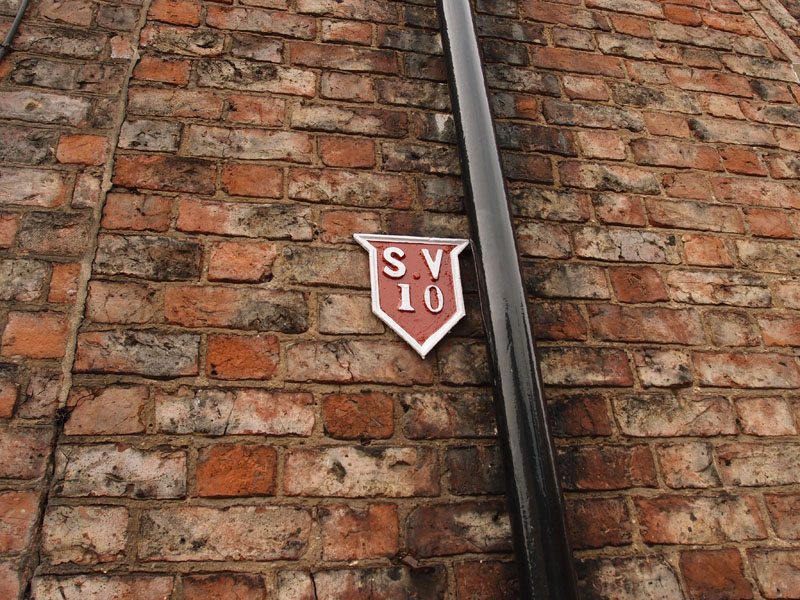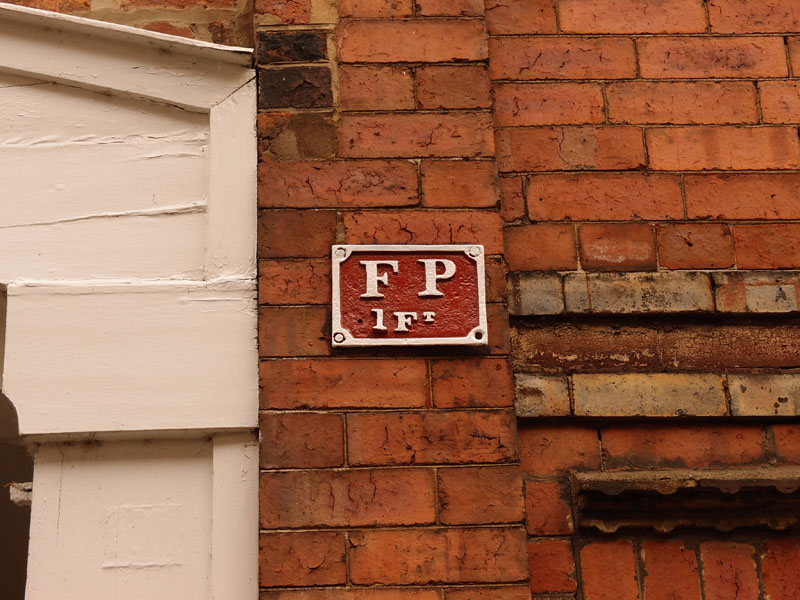At the corner of St Mary’s, where it meets Bootham, this house behind the railings has recently been refurbished, and its brickwork cleaned. One day when passing I was admiring this, and its newly painted railings, when I noticed the other newly-painted thing: the iron plate on the wall.
There are quite a few of these about, usually rusting away, blending into their surroundings. Not as obviously noticeable as this one, part of a visually pleasing ensemble of smartened things. I assumed that the new owners — or rather, more likely, painters employed by them — had painted the iron plate when they painted the railings. Nice touch, I thought.
But I’ve noticed others in other streets, on other corners. Here’s one at the top of Peckitt Street:
I often find, when compiling a page on a small detail, that researching it takes up much more time than I thought it would. I expect Googling will find the answer to everything, but it doesn’t. You have to get the right search terms, and sometimes you can’t, and sometimes even if you do all you find is other people who are also wondering what this thing is. Here’s a discussion on ‘SV’ plates, about what the SV stands for.
On another street, Ogleforth I think (though it may be Aldwark, I can’t quite remember):
This time ‘FP’ and the distance measurement of 1ft. Meaning? I don’t know. More interesting perhaps than what all these letters mean is the fact that this repainting of these iron plates is apparently connected, as they’ve all been done in the same colour scheme. It’s one of these small things that isn’t particularly important at all, in fact it’s rather boring, isn’t it. I do realise that.
So let’s liven it up by imagining a completely unlikely scenario … perhaps the owners of the Peckitt Street property saw the one on St Mary’s and thought, ‘that ‘SV’ sign looks smart, I could paint mine, and knocked on the door and said ‘do you mind if I ask you what colours you used?’ and explained why they were interested, and the St Mary’s people said ‘well, we’ve done ours now so would you like what’s left of the paint to do yours?’ And then the Ogleforth (or is it Aldwark) people saw the Peckitt St one and thought ‘our FP sign might look good like that’, and did the same knocking on the door thing, and the Peckitt St people said ‘Well, we’ve finished with the paint now, would you like it?’ And the paint is passed on through the city …
… yeah, okay, more likely it’s the York Civic Trust, or something, isn’t it. If you have insight into this matter, dear readers, your expertise and knowledge is welcome, in the comments box below.








Where I grew up we had a lot of these cast iron signs. I was told by a chap who worked for the water board (as it then was) that FP means Fire Pipe, an old name for Fire Hydrant, and SV simply means Stop Valve. He also told me what the little figures on modern Fire Hydrant signs mean, and I still like to astound people with that information when the opportunity arises. Anyway, that’s the limit of my knowledge. But just take a look at this little lot:
https://www.flickr.com/groups/1294906@N25/
FP stands for fire plug. Prior to fire hydrants firemen would dig down to the water main and bore a hole in it – the hole would fill with water that they could use for firefighting. Once the fire was extinguished they would hammer a bung or ‘plug’ into the pipe and backfill the hole, leaving an FP mark on the building for future reference. The term stuck when hydrants were introduced and their locations were marked with FP signs. Usually a square or oblong enamel sign in purple or white I’ve never seen one like yours. Generally if there’s an old FP sign there’ll be a more modern H sign too
This is really interesting, thank you Ben
I have just bought the house with the ‘FP’ sign on it (Ogleforth) so that is interesting news. ‘Fire Pipe’ is my favourite.
These were the first Insurance policies. Houses with these plates were insured and hence when the fire brigade arrived they knew they were worth saving.
Fire insurance marks were something different – they had the insurer’s logo and, usually, a policy number on them. The first fire brigades were run by insurance companies and would indeed only fight the fire if the property carried the company’s mark. You’re unlikely to see an insurance mark on a property anymore as the few surviving ones are worth a pretty penny (though replicas are available – we have around a dozen or so). There’s some good info about fire marks here: http://www.historyhouse.co.uk/articles/fire_marks.html
Pingback: Three go to Castle and Cemetery « It'll Be Reet
So, do I understand from the articles above, that FP plates occur where firemen have plugged a pipe. And by extension, that they only occur outside houses where a fire broke out necessitating firemen to access the water to put it out?
Found a large stone at a farm gate access to an old pathway/ track. It is carved with letters ST above FP and dated 1735. It is good quality letter carving complete with serif. The farm track was bisected by a new road circa 1850 as part of a new railway scheme. Wondered if it was designating an old right of way, say “Statutory footpath”, or was it simply a lovers graffiti. BTW no fire water Main or valves in the vicinity.
I have a SV plate on my property. For years I wondered what it meant. Google insists it indicates a “Sluice Valve”. Not convinced I asked a seasoned United Utilities chap. Turns out it is a “Service Valve”. Turn it off and also one further along the road and a stretch of pipe can be isolated. The tool used fits over a square, but tapered slightly to the top, and turned much the same as the stop tap serving a property. I have slept much better since!
I just found this which looks like a “Sluice Valve” design after all that
https://www.alamy.com/gate-valves-in-a-dug-trench-in-a-pavement-part-of-a-water-supply-network-in-the-uk-image519601474.html?imageid=1835ED5C-F038-4613-80D9-C50DF2F8D207&p=810080&pn=1&searchId=6a58daba522896851c15ff662d456036&searchtype=0